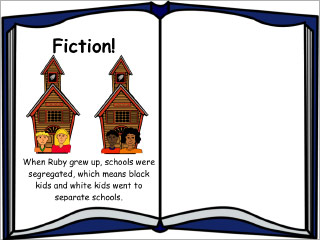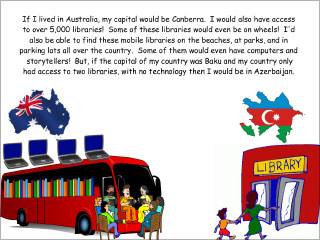
Meaningful tasks make information exciting

Depending on whom you ask, the Common Core emphasis on informational text seems to mean the end of creativity in the classroom. But a focus on informational text doesn’t automatically mandate filling in blanks, answering multiple-choice questions, or writing a traditional three-paragraph essay. In fact, when teachers choose to allow students to explore informational text independently, the opportunity for engaging, creative, and thinking projects emerges!
There’s no need to shudder at the thought of having to integrate more informational text in to your curriculum. Informational text isn’t going to bring about the death of creativity; rather, creativity depends upon what we ask students to do with the text once they’ve read it. If we ask students to read a non-fiction passage then fill out a worksheet about the passage, we are missing a chance to provide our students with an opportunity to create imaginative, artistic end products demonstrating critical thinking skills hard at work.
Here are a few ideas that illustrate how to make creativity and independent thinking come alive with great informational texts
Exemplar Informational Texts: My Five Senses, by Aliki & From Seed to Pumpkin, by Wendy Pfeffer
Creative Thinking Approach: 5 Senses Poem
In My Five Senses, Aliki takes children on a tour that explains what each of the five senses are used for and the things one may experience when using each of them. In From Seed to Pumpkin, Wendy Pfeffer takes students on a journey through the life cycle of a pumpkin. After hearing a book like this, students often answer questions as a group or cut and paste pictures to sort senses or show the life cycle process.
To boost thinking, creativity, and engagement, have students write a 5 Senses Poem with accompanying illustrations about the life cycle. In this project, students use what they learned, and activate facts they already know, about their five senses to share what they learned about the life cycle of a pumpkin. A poem might start with, “I see a tiny seed covered with dirt.” The sample 5 Senses Poem illustrates what the rest of the poem may look like.
Exemplar Informational Text: The Story of Ruby Bridges, by Robert Coles
Creative Thinking Approach: Fact or Fiction Book
In this book, Coles treats students to beautiful watercolor illustrations that help tell the story of Ruby Bridges and her role in changing the world. Commonly, after reading or listening to a biographical piece, students are asked to identify the main character and recall important details from their life, often in the form of a worksheet or traditional book report.
Building analytical and creative thinking skills, the “Fact or Fiction” report requires students to analyze the information they’ve read and consider preconceived notions, both their own and those of others. In this type of report, the student writes a statement about the topic on the right page of the book and then creates a fact or fiction response on the left side of the next page depending on whether the statement was true or false.
The student also includes an explanation of the answer as well as an illustration. When the pages of this report are bound together as a book, the reader sees the first Fact or Fiction challenge. When they turn the page, they learn the answer, see the rationale behind the answer, and read the next question.

Exemplar Informational Text: My Librarian is a Camel: How Books are Brought to Children Around the World, by Margriet Ruurs
Creative Thinking Approach: If/But Comparative
In My Librarian is a Camel, Margriet Ruurs helps readers understand how children around the world are provided access to books. Her vivid photographs make for a beautiful photo essay for book lovers around the world. This type of informational survey often results in a compare and contrast worksheet.
Comparing and contrasting is a powerful learning tool, as shown by Robert Marzano’s research in Classroom Instruction That Works, but an If/But Comparative Report allows for both creative, right-brained thinking and analytical, left-brained thinking.
The If/But Comparative report requires students to compare in narrative, first person form after they analyze topics like animals, people, places, or events. Students begin by creating a Venn diagram to identify similarities and differences and then incorporate the differences they have identified in to their If/But report. For example, in response to Ruur’s book, students may write:

Exemplar Informational Text: Freedom Walkers, the Story of the Montgomery Bus Boycott, by Russell Freedman
Creative Thinking Approach: Associative Letter Project
In Freedom Walkers, Freedman teachers readers about the injustice of racial segregation, paying special attention to the Montgomery Bus Boycott. Freedman’s vast, descriptive vocabulary along with the accompanying photographs allow readers to step inside the lives of both everyday people as well as famous individuals as they fought their way through racial injustice.
This informational text piece lends itself to having students create an associative letter project versus a traditional report. In an associative letter project, students are assigned a letter that they must use to find words representing the text they’ve just read. For example, “R is for the Montgomery Bus Boycott” might lead a student to choose words like race, rights, or Rosa as the focus of a variety of paragraphs that describe the Montgomery Bus Boycott.
Not only is this an excellent exercise in critical thinking, it also lends itself to utilization of both the dictionary and thesaurus. Since all paragraphs have to share information using the focus of a single word, it is difficult to simply copy and paste text, one of the biggest hurdles students need to overcome with informational text!
Integrating informational text into your classroom does not have to mean using mind-numbing, traditional question-and-answer methods of teaching. By providing students with meaningful, thought-provoking experiences, you can turn informational text study into an exercise in creative and critical thinking!

Follow us on Instagram for daily inspiration

Create a thought web, cluster, flowchart, or other graphic organizer for a lesson
Five ideas for creative classroom centers
Creative, digital book reviews
Fun and powerful ideas with animated characters

Wixie
Share your ideas, imagination, and understanding through writing, art, voice, and video.

Rubric Maker
Create custom rubrics for your classroom.

Pics4Learning
A curated, copyright-friendly image library that is safe and free for education.

Wriddle
Write, record, and illustrate a sentence.

Get creative classroom ideas delivered straight to your inbox once a month.
Topics